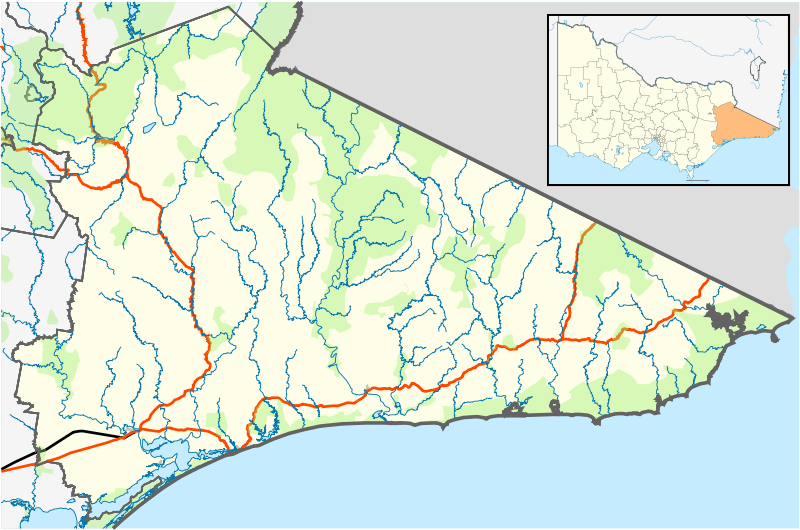Gabo Island
 Gabo Island | |
| Geography | |
|---|---|
| Location | Bass Strait |
| Coordinates | 37°33′47″S 149°54′39″E / 37.5629167°S 149.9109722°ECoordinates: 37°33′47″S 149°54′39″E / 37.5629167°S 149.9109722°E |
| Administration | |
|
Australia | |
| State | Victoria |
Gabo Island is a 154-hectare (380-acre) island located off the coast of eastern Victoria, Australia, between Mallacoota and Cape Howe on the border with New South Wales. It is separated from the mainland by a 500 metres (1,600 ft) wide channel; access is available by arranged flights and boats.[1] Gabo Island is a shipping reference commonly referred to in Victorian weather warnings issued by the Australian Bureau of Meteorology.
Gabo Island Lighthouse
It is well known for its historic lighthouse, made from pink granite quarried from the island itself, completed in 1862. The lighthouse is Australia's second tallest. The focal plane of the light is situated at 55 metres (180 ft) above sea level, the characteristic is a group of three flashes that occurs every twenty seconds. A keeper's house is occupied by a caretaker; another building may be rented for overnight stays.[2]
Climate
| Climate data for Gabo Island Lighthouse | |||||||||||||
|---|---|---|---|---|---|---|---|---|---|---|---|---|---|
| Month | Jan | Feb | Mar | Apr | May | Jun | Jul | Aug | Sep | Oct | Nov | Dec | Year |
| Record high °C (°F) | 40.8 (105.4) |
39.1 (102.4) |
38.6 (101.5) |
35.0 (95) |
26.6 (79.9) |
22.5 (72.5) |
23.3 (73.9) |
26.7 (80.1) |
31.0 (87.8) |
35.6 (96.1) |
37.2 (99) |
38.4 (101.1) |
40.8 (105.4) |
| Average high °C (°F) | 21.3 (70.3) |
21.6 (70.9) |
21.0 (69.8) |
19.2 (66.6) |
16.9 (62.4) |
14.8 (58.6) |
14.1 (57.4) |
14.7 (58.5) |
15.9 (60.6) |
17.2 (63) |
18.4 (65.1) |
19.9 (67.8) |
17.9 (64.2) |
| Average low °C (°F) | 15.8 (60.4) |
16.2 (61.2) |
15.4 (59.7) |
13.5 (56.3) |
11.2 (52.2) |
9.3 (48.7) |
8.2 (46.8) |
8.5 (47.3) |
9.7 (49.5) |
11.2 (52.2) |
12.8 (55) |
14.4 (57.9) |
12.2 (54) |
| Record low °C (°F) | 6.3 (43.3) |
7.8 (46) |
7.8 (46) |
6.4 (43.5) |
2.2 (36) |
3.3 (37.9) |
2.0 (35.6) |
2.8 (37) |
2.8 (37) |
2.8 (37) |
1.7 (35.1) |
7.2 (45) |
1.7 (35.1) |
| Average precipitation mm (inches) | 70.2 (2.764) |
67.7 (2.665) |
72.5 (2.854) |
84.4 (3.323) |
98.3 (3.87) |
103.4 (4.071) |
85.4 (3.362) |
71.5 (2.815) |
72.5 (2.854) |
74.4 (2.929) |
73.1 (2.878) |
66.7 (2.626) |
941.9 (37.083) |
| Average precipitation days | 9.4 | 9.1 | 10.6 | 11.8 | 13.4 | 14.4 | 13.7 | 13.3 | 13.3 | 13.3 | 11.6 | 10.8 | 144.7 |
| Source: Bureau of Meteorology[3] | |||||||||||||
Birds
The island is home to the world's largest colony of little penguins.[1] Gabo, with the tiny associated islet of Tullaberga at its southern end, has been identified by BirdLife International as an Important Bird Area because of the numbers of breeding penguins (up to 21,000 pairs) and white-faced storm petrels (up to 20,000 pairs).[4]
 Map of Gabo Island, Victoria, Australia
Map of Gabo Island, Victoria, Australia Map of Gabo Island
Map of Gabo Island
References
- 1 2 Parks Victoria. "Gabo Island".
- ↑ Rowlett, Russ. "Lighthouses of Australia: Victoria". The Lighthouse Directory. University of North Carolina at Chapel Hill.
- ↑ "Climate Statistics for Gabo Island Lighthouse". Climate statistics for Australian locations. Bureau of Meteorology. Retrieved 13 November 2016.
- ↑ "IBA: Gabo and Tullaberga Islands". Birdata. Birds Australia. Retrieved 2011-06-23.